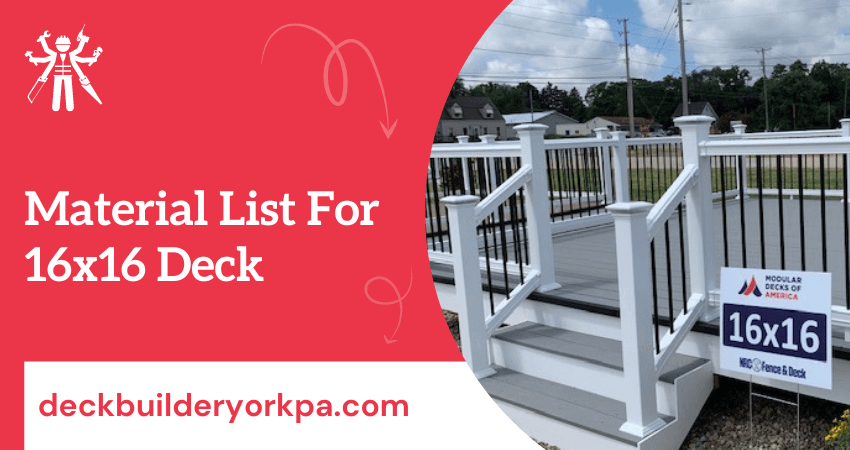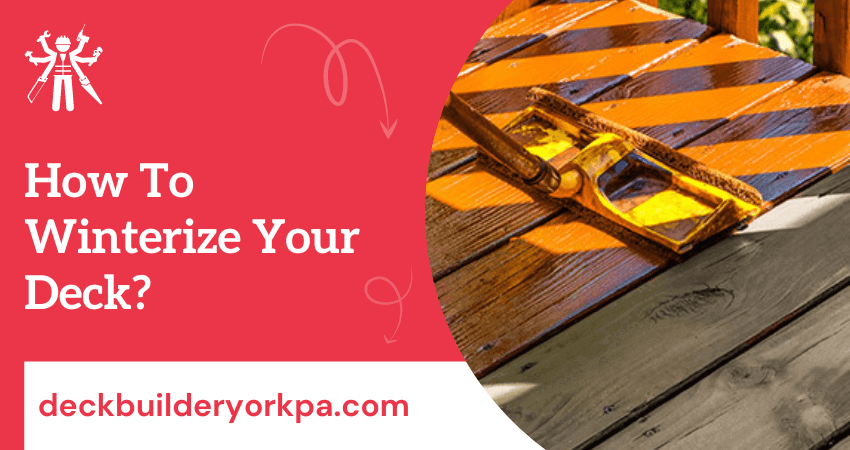Are you ready to make your outdoor living dreams a reality? Decks are increasingly becoming the go-to accessory for summer barbecues, backyard parties and just leisurely relaxing outdoors. But before you can enjoy all these great activities on your new deck, there’s one crucial step: planning.
Knowing exactly what materials you need is essential when it comes time to build. A 16×16 deck material list will help streamline this process so that by the end of it, you’ll have a perfect setup ready for years of enjoyment!
Material For Deck Building
Building a deck is a great way to add extra living space and value to your home. With careful planning and the right materials, you can build a beautiful deck that will last for years.
To begin, decide on the type of material you want to use for your deck. You can choose from wood, plastic composite, or metal, each with its advantages and disadvantages. For example, wood is the most popular choice for decks because it’s strong and durable, but it requires regular maintenance like sealing or painting.
A plastic composite is an affordable option that can last for years with little upkeep required, but it may not be as attractive as a wooden deck. Once you have chosen your material, sketch your deck plan. While planning, think about the traffic flow within your backyard that the deck will need to accommodate. Measure out each board or piece of metal so you know exactly how much material you’ll need.
Next, prepare the area where you will build your deck. Clear away any grass or weeds and level the soil before laying a foundation. You can use concrete blocks or gravel to create a level surface, depending on what material you’re using for the floor of your deck.
Types Of Materials Available For Deck Building
Following are the types of materials that can be used for deck building.
- Wood: The most common type of material used to build decks is wood. It is durable, attractive and relatively inexpensive compared to other options. Popular wood choices for decks include pressure-treated lumber, cedar, redwood and ipe (Brazilian hardwood).
- Composite: Composite decking is made from a blend of wood fibers and plastic polymers. It is often touted as being more durable than traditional wood, although it can be susceptible to scratches, staining and fading if not maintained properly.
- Aluminum: Aluminum decks are very low-maintenance, easy to clean and resist rotting, splintering and cracking. Although it is more expensive than wood or composite, aluminum is a great choice if you’re looking for a long-lasting deck material that requires minimal upkeep.
- Plastic: This type of decking is made from 100 percent plastic and contains no wood fibers. It’s highly resistant to rot, fading, staining and scratches. It’s also lightweight and easy to install.
- PVC: Similar to plastic decking, PVC (polyvinyl chloride) is a synthetic material that offers enhanced durability and resistance against rot and insects. Although it’s not as strong or durable as aluminum or composite decking, it’s a great option for those on a tight budget.
Each has its benefits and drawbacks.
For example, wood is less expensive and more aesthetically pleasing, but it may require more maintenance and can be prone to rot. On the other hand, aluminum costs more but is low-maintenance and resistant to rot. Ultimately, the choice of material should be based on your budget and preferences.
There are also a variety of specialized deck materials available for specific applications such as hot tubs or pool decks. Talk to a local contractor to discuss the best option for your particular project.
Regardless of which material you choose, be sure to read up on proper maintenance and installation instructions so that your deck can last for years to come.
No matter what type of material you choose, it’s important to ensure that your deck is sealed and maintained properly. This will help protect the material from water damage and extend its life span. Additionally, using quality fasteners during installation and cleaning your deck regularly will help ensure it looks great for years to come.
How to choose the best material for your specific deck project?
When choosing the material for your deck, you should consider factors such as strength and durability, aesthetic appeal, budget, maintenance requirements and any special applications (like hot tubs or pools). It’s also important to understand how each type of material will perform in your climate. Talk to a local contractor about the best options for your specific project.
But most of the time, the choice comes down to a few popular materials: wood, composite decking or aluminum.
Material List For 16×16 Deck
The following listed material is required to build a 16×16 deck and the Average are:
- Pressure-treated lumber: 16 2x6x8 boards and 12 2x6x12 boards would cost approximately $220.
- Deck screws: 4lbs of 3″ screws and 6lbs of 2 1/2″ screws would cost approximately $25.
- Joist hangers: 24 – 8d galvanized nails would cost approximately $12.
- Lag screws and washers: 4 1/2″ lag screws with washers would cost approximately $18.
- Decking: 16 2×6 boards, 8′ in length would cost approximately $120.
- Hinges: 4 gate hinges would cost approximately $25.
- Railing posts: 6 – 4×4 posts, 8ft in length would cost approximately $90.
- Railing pickets: 70 – 2×2 pickets would cost approximately $50.
- Railing balusters: 4 – 1×2 balusters would cost approximately $10.
- Lattice panels: 1 panel, 4ft x 8ft would cost approximately $30.
- Stair stringers: 3 2×12 stair stringers would cost approximately $90.
- Deck Stain/Paint: one gallon of semi-transparent stain or paint would cost approximately $20.
- Deck sealant: one gallon of waterproof sealant would cost approximately $15.
- Nails and screws: 16d galvanized nails, 2 1/2″, 3″ deck screws would cost approximately $15.
- Miscellaneous items such as sandpaper, saw blades, power drill, etc. would cost approximately $50.
Total Material Cost: Approximately $700
Note: This is just an estimate and may not reflect the actual costs of materials. Prices may vary according to the location and availability of supplies, as well as other factors. It is always best to consult a professional contractor to get an accurate estimate for your project.
The material list above will help you prepare for building your 16×16 deck; however, it is important to also consider the labor costs associated with the project. Professional contractors can provide you with an accurate quote of labor and material costs, as well as other important information such as building codes in your area.
Ultimately, it is up to you to determine what materials are necessary for your 16×16 deck project and how much it will cost. With careful planning and preparation, you can be sure that your deck will turn out exactly as you had dreamed and hoped.
Wrap Up
Overall, having a 16×16 deck material list on hand will be an essential tool for any aspiring deck builder in York. Knowing what materials are required to build a deck takes the guesswork out of the process and gives people the confidence they need to try a new project.
Furthermore, it can help to ensure that your deck is completed most safely and reliably possible. With a comprehensive 16×16 material list at your disposal, you’ll have all the information you need to construct beautiful and long-lasting decks.
Having access to this sort of information is invaluable, especially when some more complicated projects require more specialized items like footings or railings. It’s always best to be well-prepared before starting such an important endeavor as constructing a deck for your home or business.



